Analysis of Employment Relations Case Study, University, Semester 1
VerifiedAdded on 2020/04/01
|6
|2654
|42
Homework Assignment
AI Summary
This assignment analyzes a case study involving Worksites Company Limited and Ms. Adnelg Retrop, focusing on the nature of their employment relationship. It distinguishes between contracts of service and contracts for service, determining Ms. Retrop's status as an employee. The analysis applies tests to define the contractual relationship and explores advantages and disadvantages for both employers and employees in different contractual arrangements. The assignment further outlines essential provisions for Individual Employment Agreements (IEA) and Collective Employment Agreements (CEA), including statutory terms. It defines 'employment relations problems' under the Employment Relations Act 2000, identifies the central issue in the case study, and details the act's provisions applicable to the situation. Finally, it proposes options and steps for resolving the employment relations problem, as provided by the act, including mediation, labor authority intervention, and potential court proceedings.
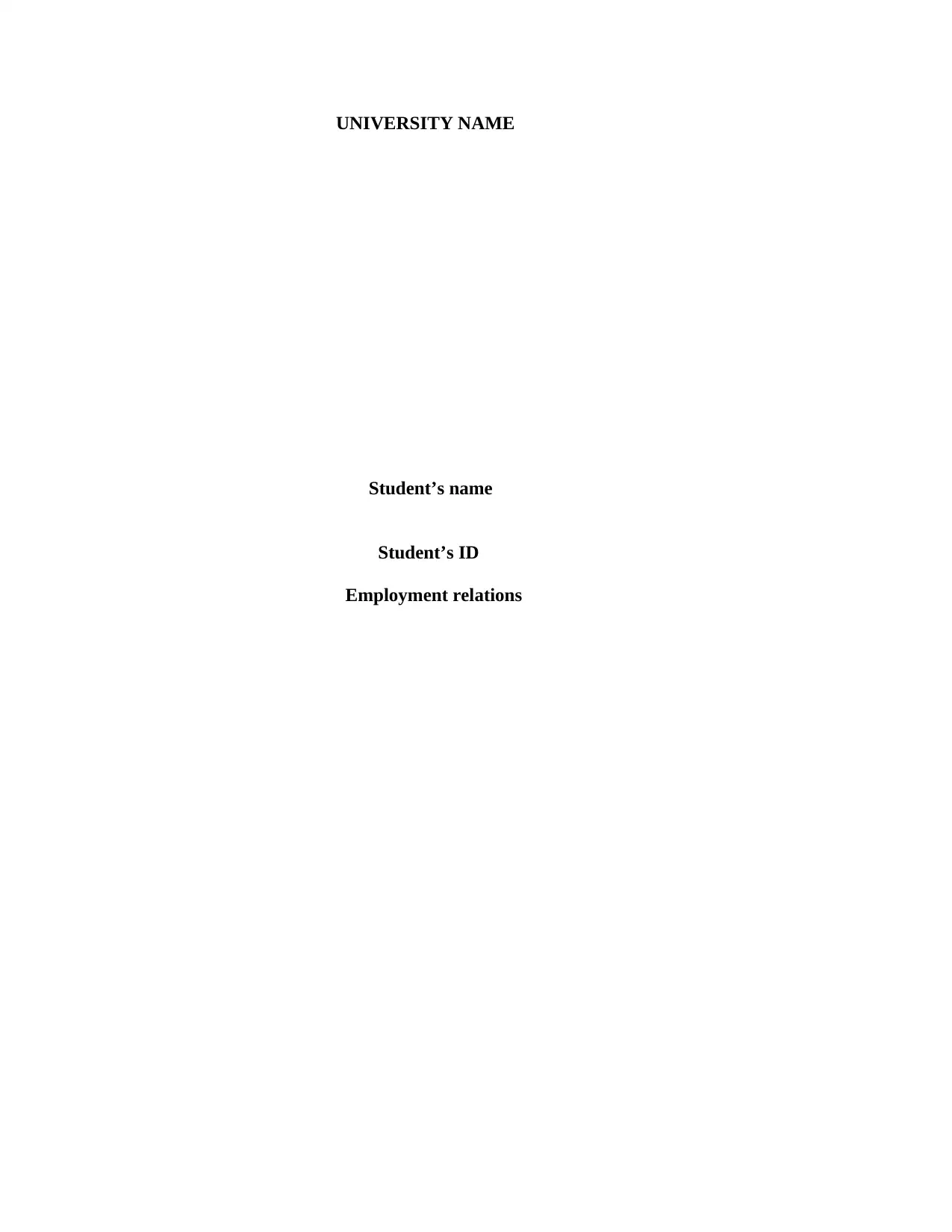
UNIVERSITY NAME
Student’s name
Student’s ID
Employment relations
Student’s name
Student’s ID
Employment relations
Paraphrase This Document
Need a fresh take? Get an instant paraphrase of this document with our AI Paraphraser
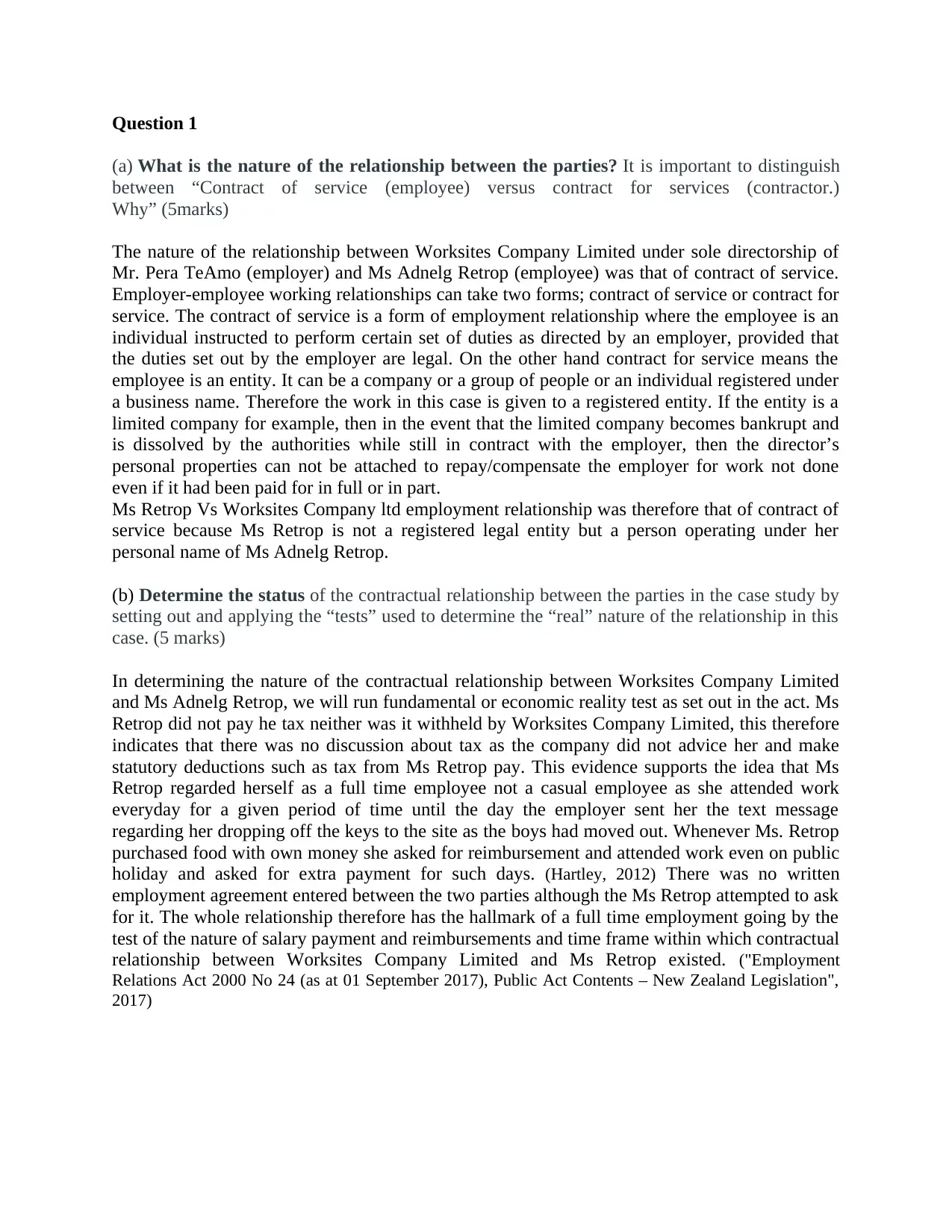
Question 1
(a) What is the nature of the relationship between the parties? It is important to distinguish
between “Contract of service (employee) versus contract for services (contractor.)
Why” (5marks)
The nature of the relationship between Worksites Company Limited under sole directorship of
Mr. Pera TeAmo (employer) and Ms Adnelg Retrop (employee) was that of contract of service.
Employer-employee working relationships can take two forms; contract of service or contract for
service. The contract of service is a form of employment relationship where the employee is an
individual instructed to perform certain set of duties as directed by an employer, provided that
the duties set out by the employer are legal. On the other hand contract for service means the
employee is an entity. It can be a company or a group of people or an individual registered under
a business name. Therefore the work in this case is given to a registered entity. If the entity is a
limited company for example, then in the event that the limited company becomes bankrupt and
is dissolved by the authorities while still in contract with the employer, then the director’s
personal properties can not be attached to repay/compensate the employer for work not done
even if it had been paid for in full or in part.
Ms Retrop Vs Worksites Company ltd employment relationship was therefore that of contract of
service because Ms Retrop is not a registered legal entity but a person operating under her
personal name of Ms Adnelg Retrop.
(b) Determine the status of the contractual relationship between the parties in the case study by
setting out and applying the “tests” used to determine the “real” nature of the relationship in this
case. (5 marks)
In determining the nature of the contractual relationship between Worksites Company Limited
and Ms Adnelg Retrop, we will run fundamental or economic reality test as set out in the act. Ms
Retrop did not pay he tax neither was it withheld by Worksites Company Limited, this therefore
indicates that there was no discussion about tax as the company did not advice her and make
statutory deductions such as tax from Ms Retrop pay. This evidence supports the idea that Ms
Retrop regarded herself as a full time employee not a casual employee as she attended work
everyday for a given period of time until the day the employer sent her the text message
regarding her dropping off the keys to the site as the boys had moved out. Whenever Ms. Retrop
purchased food with own money she asked for reimbursement and attended work even on public
holiday and asked for extra payment for such days. (Hartley, 2012) There was no written
employment agreement entered between the two parties although the Ms Retrop attempted to ask
for it. The whole relationship therefore has the hallmark of a full time employment going by the
test of the nature of salary payment and reimbursements and time frame within which contractual
relationship between Worksites Company Limited and Ms Retrop existed. ("Employment
Relations Act 2000 No 24 (as at 01 September 2017), Public Act Contents – New Zealand Legislation",
2017)
(a) What is the nature of the relationship between the parties? It is important to distinguish
between “Contract of service (employee) versus contract for services (contractor.)
Why” (5marks)
The nature of the relationship between Worksites Company Limited under sole directorship of
Mr. Pera TeAmo (employer) and Ms Adnelg Retrop (employee) was that of contract of service.
Employer-employee working relationships can take two forms; contract of service or contract for
service. The contract of service is a form of employment relationship where the employee is an
individual instructed to perform certain set of duties as directed by an employer, provided that
the duties set out by the employer are legal. On the other hand contract for service means the
employee is an entity. It can be a company or a group of people or an individual registered under
a business name. Therefore the work in this case is given to a registered entity. If the entity is a
limited company for example, then in the event that the limited company becomes bankrupt and
is dissolved by the authorities while still in contract with the employer, then the director’s
personal properties can not be attached to repay/compensate the employer for work not done
even if it had been paid for in full or in part.
Ms Retrop Vs Worksites Company ltd employment relationship was therefore that of contract of
service because Ms Retrop is not a registered legal entity but a person operating under her
personal name of Ms Adnelg Retrop.
(b) Determine the status of the contractual relationship between the parties in the case study by
setting out and applying the “tests” used to determine the “real” nature of the relationship in this
case. (5 marks)
In determining the nature of the contractual relationship between Worksites Company Limited
and Ms Adnelg Retrop, we will run fundamental or economic reality test as set out in the act. Ms
Retrop did not pay he tax neither was it withheld by Worksites Company Limited, this therefore
indicates that there was no discussion about tax as the company did not advice her and make
statutory deductions such as tax from Ms Retrop pay. This evidence supports the idea that Ms
Retrop regarded herself as a full time employee not a casual employee as she attended work
everyday for a given period of time until the day the employer sent her the text message
regarding her dropping off the keys to the site as the boys had moved out. Whenever Ms. Retrop
purchased food with own money she asked for reimbursement and attended work even on public
holiday and asked for extra payment for such days. (Hartley, 2012) There was no written
employment agreement entered between the two parties although the Ms Retrop attempted to ask
for it. The whole relationship therefore has the hallmark of a full time employment going by the
test of the nature of salary payment and reimbursements and time frame within which contractual
relationship between Worksites Company Limited and Ms Retrop existed. ("Employment
Relations Act 2000 No 24 (as at 01 September 2017), Public Act Contents – New Zealand Legislation",
2017)
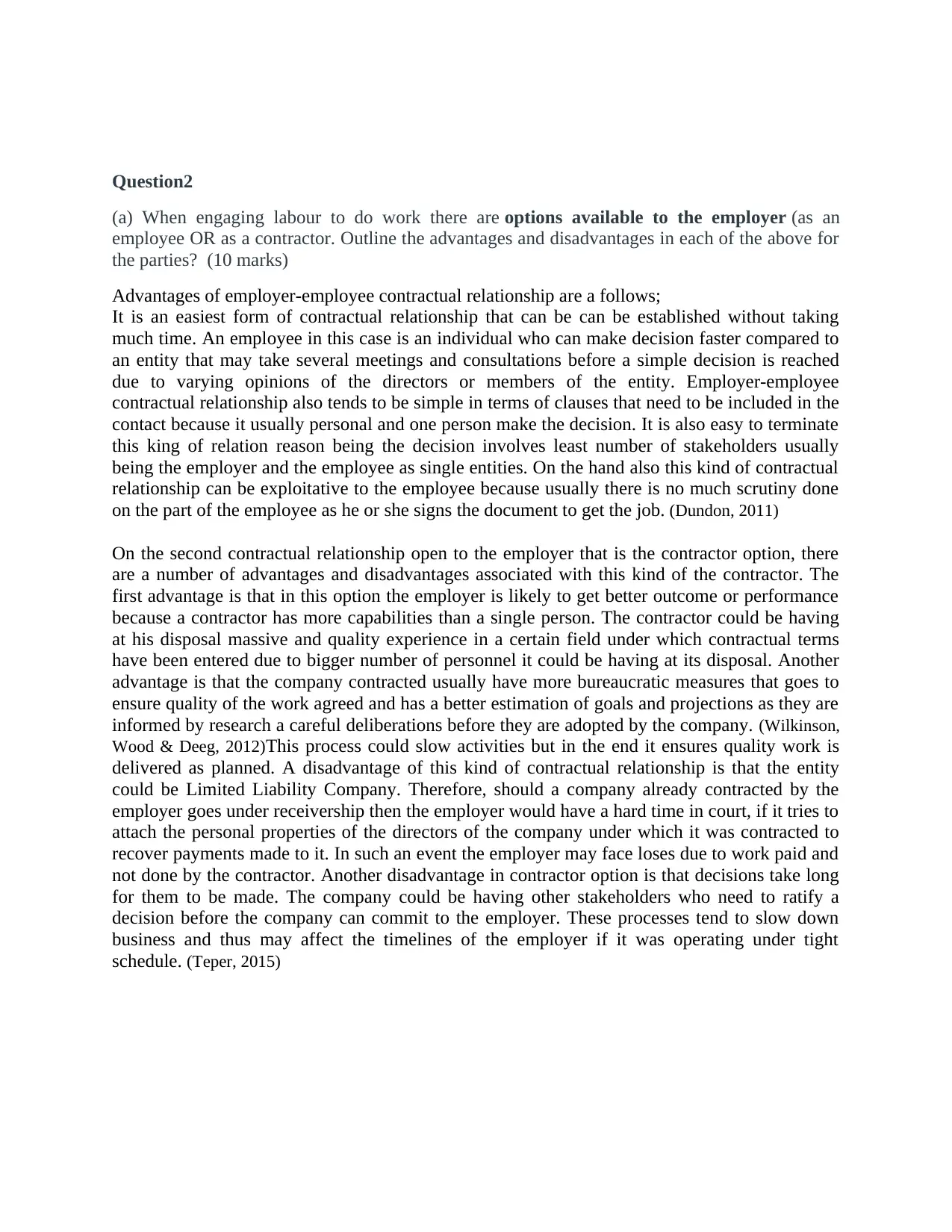
Question2
(a) When engaging labour to do work there are options available to the employer (as an
employee OR as a contractor. Outline the advantages and disadvantages in each of the above for
the parties? (10 marks)
Advantages of employer-employee contractual relationship are a follows;
It is an easiest form of contractual relationship that can be can be established without taking
much time. An employee in this case is an individual who can make decision faster compared to
an entity that may take several meetings and consultations before a simple decision is reached
due to varying opinions of the directors or members of the entity. Employer-employee
contractual relationship also tends to be simple in terms of clauses that need to be included in the
contact because it usually personal and one person make the decision. It is also easy to terminate
this king of relation reason being the decision involves least number of stakeholders usually
being the employer and the employee as single entities. On the hand also this kind of contractual
relationship can be exploitative to the employee because usually there is no much scrutiny done
on the part of the employee as he or she signs the document to get the job. (Dundon, 2011)
On the second contractual relationship open to the employer that is the contractor option, there
are a number of advantages and disadvantages associated with this kind of the contractor. The
first advantage is that in this option the employer is likely to get better outcome or performance
because a contractor has more capabilities than a single person. The contractor could be having
at his disposal massive and quality experience in a certain field under which contractual terms
have been entered due to bigger number of personnel it could be having at its disposal. Another
advantage is that the company contracted usually have more bureaucratic measures that goes to
ensure quality of the work agreed and has a better estimation of goals and projections as they are
informed by research a careful deliberations before they are adopted by the company. (Wilkinson,
Wood & Deeg, 2012)This process could slow activities but in the end it ensures quality work is
delivered as planned. A disadvantage of this kind of contractual relationship is that the entity
could be Limited Liability Company. Therefore, should a company already contracted by the
employer goes under receivership then the employer would have a hard time in court, if it tries to
attach the personal properties of the directors of the company under which it was contracted to
recover payments made to it. In such an event the employer may face loses due to work paid and
not done by the contractor. Another disadvantage in contractor option is that decisions take long
for them to be made. The company could be having other stakeholders who need to ratify a
decision before the company can commit to the employer. These processes tend to slow down
business and thus may affect the timelines of the employer if it was operating under tight
schedule. (Teper, 2015)
(a) When engaging labour to do work there are options available to the employer (as an
employee OR as a contractor. Outline the advantages and disadvantages in each of the above for
the parties? (10 marks)
Advantages of employer-employee contractual relationship are a follows;
It is an easiest form of contractual relationship that can be can be established without taking
much time. An employee in this case is an individual who can make decision faster compared to
an entity that may take several meetings and consultations before a simple decision is reached
due to varying opinions of the directors or members of the entity. Employer-employee
contractual relationship also tends to be simple in terms of clauses that need to be included in the
contact because it usually personal and one person make the decision. It is also easy to terminate
this king of relation reason being the decision involves least number of stakeholders usually
being the employer and the employee as single entities. On the hand also this kind of contractual
relationship can be exploitative to the employee because usually there is no much scrutiny done
on the part of the employee as he or she signs the document to get the job. (Dundon, 2011)
On the second contractual relationship open to the employer that is the contractor option, there
are a number of advantages and disadvantages associated with this kind of the contractor. The
first advantage is that in this option the employer is likely to get better outcome or performance
because a contractor has more capabilities than a single person. The contractor could be having
at his disposal massive and quality experience in a certain field under which contractual terms
have been entered due to bigger number of personnel it could be having at its disposal. Another
advantage is that the company contracted usually have more bureaucratic measures that goes to
ensure quality of the work agreed and has a better estimation of goals and projections as they are
informed by research a careful deliberations before they are adopted by the company. (Wilkinson,
Wood & Deeg, 2012)This process could slow activities but in the end it ensures quality work is
delivered as planned. A disadvantage of this kind of contractual relationship is that the entity
could be Limited Liability Company. Therefore, should a company already contracted by the
employer goes under receivership then the employer would have a hard time in court, if it tries to
attach the personal properties of the directors of the company under which it was contracted to
recover payments made to it. In such an event the employer may face loses due to work paid and
not done by the contractor. Another disadvantage in contractor option is that decisions take long
for them to be made. The company could be having other stakeholders who need to ratify a
decision before the company can commit to the employer. These processes tend to slow down
business and thus may affect the timelines of the employer if it was operating under tight
schedule. (Teper, 2015)
⊘ This is a preview!⊘
Do you want full access?
Subscribe today to unlock all pages.

Trusted by 1+ million students worldwide
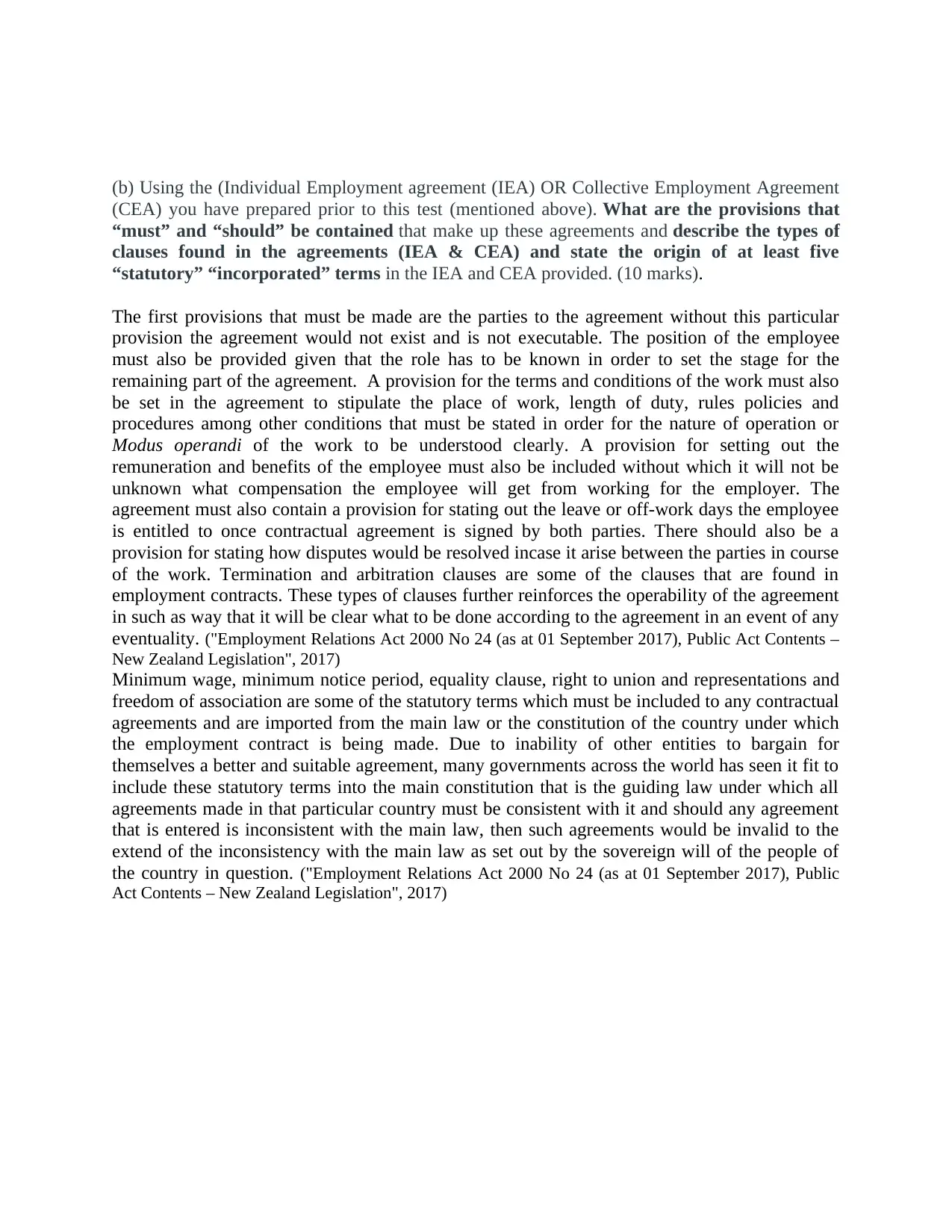
(b) Using the (Individual Employment agreement (IEA) OR Collective Employment Agreement
(CEA) you have prepared prior to this test (mentioned above). What are the provisions that
“must” and “should” be contained that make up these agreements and describe the types of
clauses found in the agreements (IEA & CEA) and state the origin of at least five
“statutory” “incorporated” terms in the IEA and CEA provided. (10 marks).
The first provisions that must be made are the parties to the agreement without this particular
provision the agreement would not exist and is not executable. The position of the employee
must also be provided given that the role has to be known in order to set the stage for the
remaining part of the agreement. A provision for the terms and conditions of the work must also
be set in the agreement to stipulate the place of work, length of duty, rules policies and
procedures among other conditions that must be stated in order for the nature of operation or
Modus operandi of the work to be understood clearly. A provision for setting out the
remuneration and benefits of the employee must also be included without which it will not be
unknown what compensation the employee will get from working for the employer. The
agreement must also contain a provision for stating out the leave or off-work days the employee
is entitled to once contractual agreement is signed by both parties. There should also be a
provision for stating how disputes would be resolved incase it arise between the parties in course
of the work. Termination and arbitration clauses are some of the clauses that are found in
employment contracts. These types of clauses further reinforces the operability of the agreement
in such as way that it will be clear what to be done according to the agreement in an event of any
eventuality. ("Employment Relations Act 2000 No 24 (as at 01 September 2017), Public Act Contents –
New Zealand Legislation", 2017)
Minimum wage, minimum notice period, equality clause, right to union and representations and
freedom of association are some of the statutory terms which must be included to any contractual
agreements and are imported from the main law or the constitution of the country under which
the employment contract is being made. Due to inability of other entities to bargain for
themselves a better and suitable agreement, many governments across the world has seen it fit to
include these statutory terms into the main constitution that is the guiding law under which all
agreements made in that particular country must be consistent with it and should any agreement
that is entered is inconsistent with the main law, then such agreements would be invalid to the
extend of the inconsistency with the main law as set out by the sovereign will of the people of
the country in question. ("Employment Relations Act 2000 No 24 (as at 01 September 2017), Public
Act Contents – New Zealand Legislation", 2017)
(CEA) you have prepared prior to this test (mentioned above). What are the provisions that
“must” and “should” be contained that make up these agreements and describe the types of
clauses found in the agreements (IEA & CEA) and state the origin of at least five
“statutory” “incorporated” terms in the IEA and CEA provided. (10 marks).
The first provisions that must be made are the parties to the agreement without this particular
provision the agreement would not exist and is not executable. The position of the employee
must also be provided given that the role has to be known in order to set the stage for the
remaining part of the agreement. A provision for the terms and conditions of the work must also
be set in the agreement to stipulate the place of work, length of duty, rules policies and
procedures among other conditions that must be stated in order for the nature of operation or
Modus operandi of the work to be understood clearly. A provision for setting out the
remuneration and benefits of the employee must also be included without which it will not be
unknown what compensation the employee will get from working for the employer. The
agreement must also contain a provision for stating out the leave or off-work days the employee
is entitled to once contractual agreement is signed by both parties. There should also be a
provision for stating how disputes would be resolved incase it arise between the parties in course
of the work. Termination and arbitration clauses are some of the clauses that are found in
employment contracts. These types of clauses further reinforces the operability of the agreement
in such as way that it will be clear what to be done according to the agreement in an event of any
eventuality. ("Employment Relations Act 2000 No 24 (as at 01 September 2017), Public Act Contents –
New Zealand Legislation", 2017)
Minimum wage, minimum notice period, equality clause, right to union and representations and
freedom of association are some of the statutory terms which must be included to any contractual
agreements and are imported from the main law or the constitution of the country under which
the employment contract is being made. Due to inability of other entities to bargain for
themselves a better and suitable agreement, many governments across the world has seen it fit to
include these statutory terms into the main constitution that is the guiding law under which all
agreements made in that particular country must be consistent with it and should any agreement
that is entered is inconsistent with the main law, then such agreements would be invalid to the
extend of the inconsistency with the main law as set out by the sovereign will of the people of
the country in question. ("Employment Relations Act 2000 No 24 (as at 01 September 2017), Public
Act Contents – New Zealand Legislation", 2017)
Paraphrase This Document
Need a fresh take? Get an instant paraphrase of this document with our AI Paraphraser
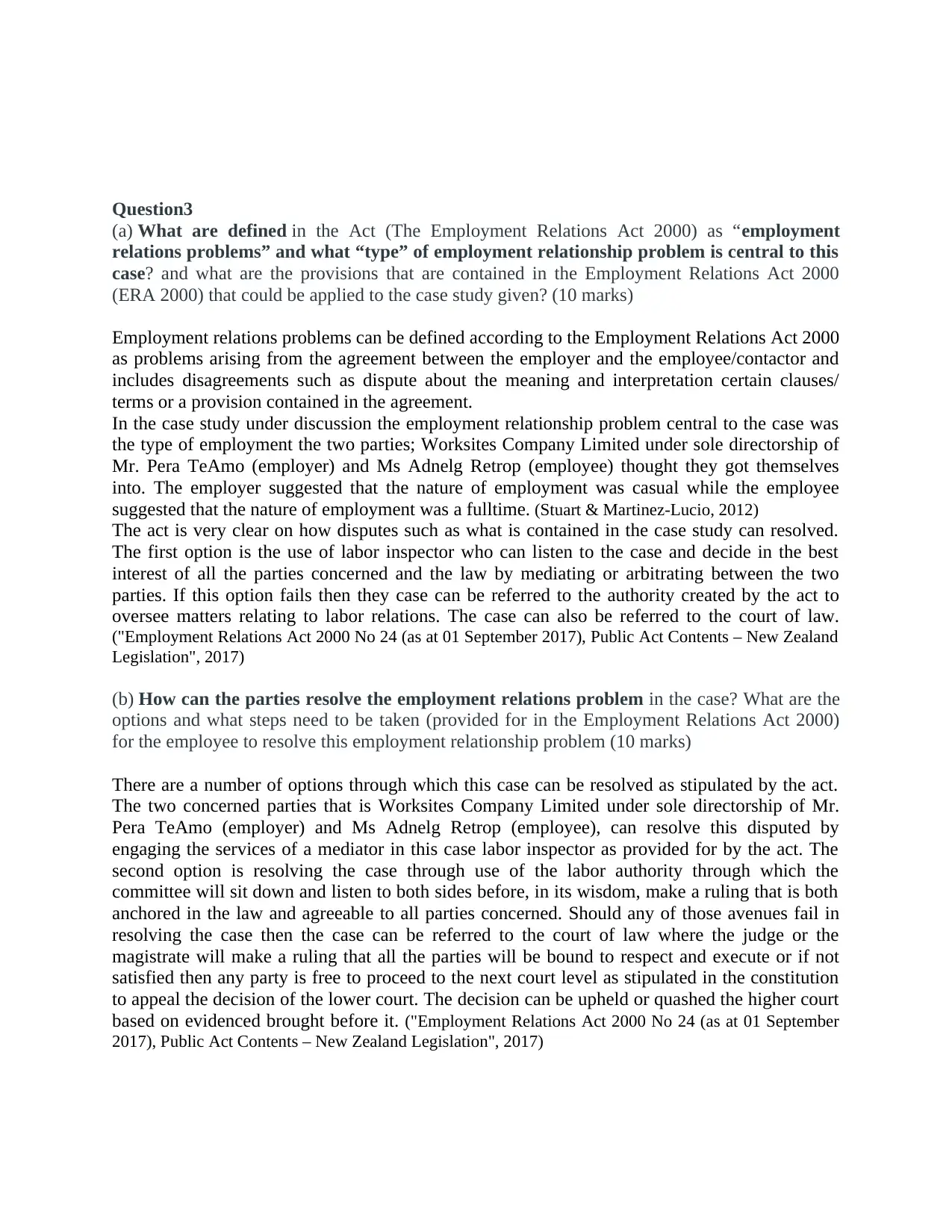
Question3
(a) What are defined in the Act (The Employment Relations Act 2000) as “employment
relations problems” and what “type” of employment relationship problem is central to this
case? and what are the provisions that are contained in the Employment Relations Act 2000
(ERA 2000) that could be applied to the case study given? (10 marks)
Employment relations problems can be defined according to the Employment Relations Act 2000
as problems arising from the agreement between the employer and the employee/contactor and
includes disagreements such as dispute about the meaning and interpretation certain clauses/
terms or a provision contained in the agreement.
In the case study under discussion the employment relationship problem central to the case was
the type of employment the two parties; Worksites Company Limited under sole directorship of
Mr. Pera TeAmo (employer) and Ms Adnelg Retrop (employee) thought they got themselves
into. The employer suggested that the nature of employment was casual while the employee
suggested that the nature of employment was a fulltime. (Stuart & Martinez-Lucio, 2012)
The act is very clear on how disputes such as what is contained in the case study can resolved.
The first option is the use of labor inspector who can listen to the case and decide in the best
interest of all the parties concerned and the law by mediating or arbitrating between the two
parties. If this option fails then they case can be referred to the authority created by the act to
oversee matters relating to labor relations. The case can also be referred to the court of law.
("Employment Relations Act 2000 No 24 (as at 01 September 2017), Public Act Contents – New Zealand
Legislation", 2017)
(b) How can the parties resolve the employment relations problem in the case? What are the
options and what steps need to be taken (provided for in the Employment Relations Act 2000)
for the employee to resolve this employment relationship problem (10 marks)
There are a number of options through which this case can be resolved as stipulated by the act.
The two concerned parties that is Worksites Company Limited under sole directorship of Mr.
Pera TeAmo (employer) and Ms Adnelg Retrop (employee), can resolve this disputed by
engaging the services of a mediator in this case labor inspector as provided for by the act. The
second option is resolving the case through use of the labor authority through which the
committee will sit down and listen to both sides before, in its wisdom, make a ruling that is both
anchored in the law and agreeable to all parties concerned. Should any of those avenues fail in
resolving the case then the case can be referred to the court of law where the judge or the
magistrate will make a ruling that all the parties will be bound to respect and execute or if not
satisfied then any party is free to proceed to the next court level as stipulated in the constitution
to appeal the decision of the lower court. The decision can be upheld or quashed the higher court
based on evidenced brought before it. ("Employment Relations Act 2000 No 24 (as at 01 September
2017), Public Act Contents – New Zealand Legislation", 2017)
(a) What are defined in the Act (The Employment Relations Act 2000) as “employment
relations problems” and what “type” of employment relationship problem is central to this
case? and what are the provisions that are contained in the Employment Relations Act 2000
(ERA 2000) that could be applied to the case study given? (10 marks)
Employment relations problems can be defined according to the Employment Relations Act 2000
as problems arising from the agreement between the employer and the employee/contactor and
includes disagreements such as dispute about the meaning and interpretation certain clauses/
terms or a provision contained in the agreement.
In the case study under discussion the employment relationship problem central to the case was
the type of employment the two parties; Worksites Company Limited under sole directorship of
Mr. Pera TeAmo (employer) and Ms Adnelg Retrop (employee) thought they got themselves
into. The employer suggested that the nature of employment was casual while the employee
suggested that the nature of employment was a fulltime. (Stuart & Martinez-Lucio, 2012)
The act is very clear on how disputes such as what is contained in the case study can resolved.
The first option is the use of labor inspector who can listen to the case and decide in the best
interest of all the parties concerned and the law by mediating or arbitrating between the two
parties. If this option fails then they case can be referred to the authority created by the act to
oversee matters relating to labor relations. The case can also be referred to the court of law.
("Employment Relations Act 2000 No 24 (as at 01 September 2017), Public Act Contents – New Zealand
Legislation", 2017)
(b) How can the parties resolve the employment relations problem in the case? What are the
options and what steps need to be taken (provided for in the Employment Relations Act 2000)
for the employee to resolve this employment relationship problem (10 marks)
There are a number of options through which this case can be resolved as stipulated by the act.
The two concerned parties that is Worksites Company Limited under sole directorship of Mr.
Pera TeAmo (employer) and Ms Adnelg Retrop (employee), can resolve this disputed by
engaging the services of a mediator in this case labor inspector as provided for by the act. The
second option is resolving the case through use of the labor authority through which the
committee will sit down and listen to both sides before, in its wisdom, make a ruling that is both
anchored in the law and agreeable to all parties concerned. Should any of those avenues fail in
resolving the case then the case can be referred to the court of law where the judge or the
magistrate will make a ruling that all the parties will be bound to respect and execute or if not
satisfied then any party is free to proceed to the next court level as stipulated in the constitution
to appeal the decision of the lower court. The decision can be upheld or quashed the higher court
based on evidenced brought before it. ("Employment Relations Act 2000 No 24 (as at 01 September
2017), Public Act Contents – New Zealand Legislation", 2017)
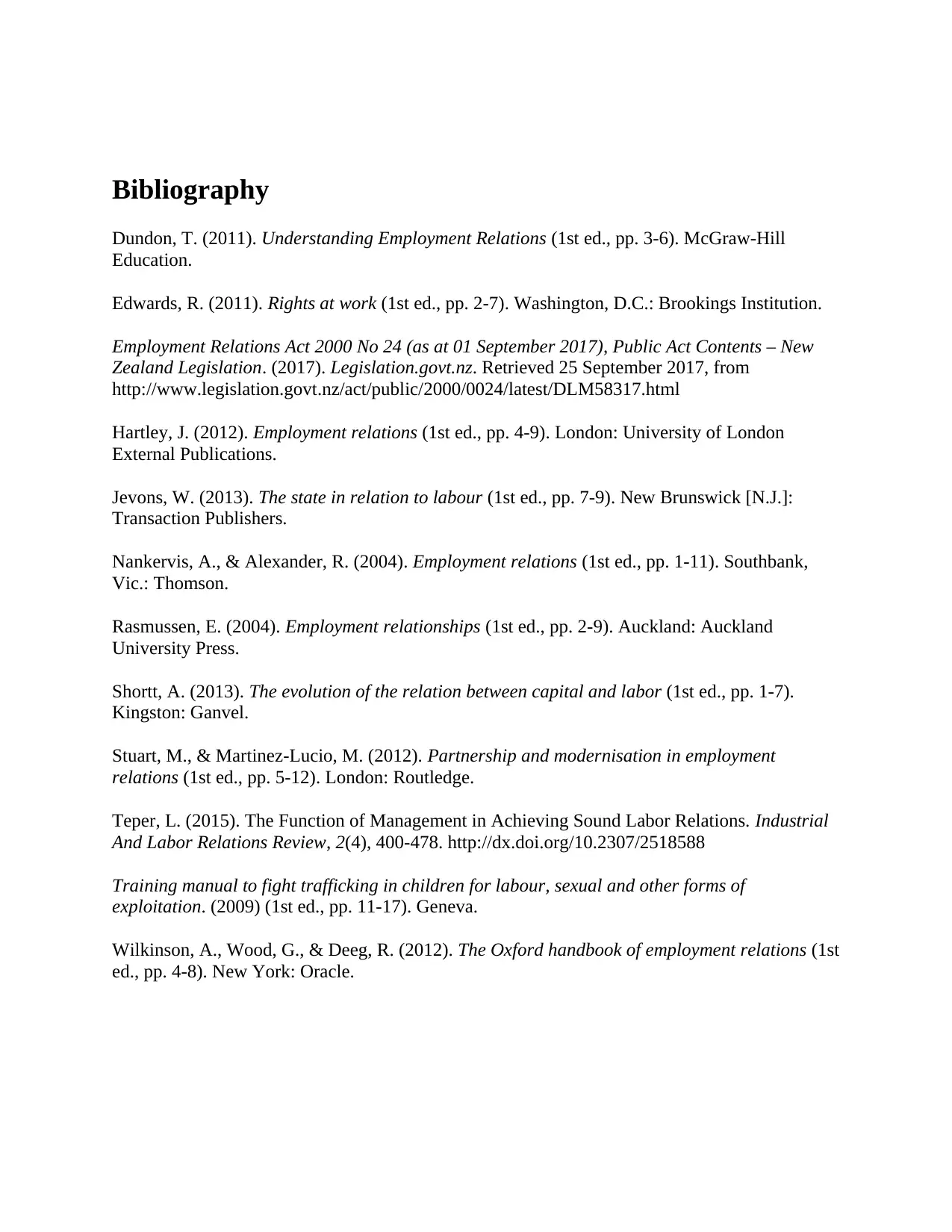
Bibliography
Dundon, T. (2011). Understanding Employment Relations (1st ed., pp. 3-6). McGraw-Hill
Education.
Edwards, R. (2011). Rights at work (1st ed., pp. 2-7). Washington, D.C.: Brookings Institution.
Employment Relations Act 2000 No 24 (as at 01 September 2017), Public Act Contents – New
Zealand Legislation. (2017). Legislation.govt.nz. Retrieved 25 September 2017, from
http://www.legislation.govt.nz/act/public/2000/0024/latest/DLM58317.html
Hartley, J. (2012). Employment relations (1st ed., pp. 4-9). London: University of London
External Publications.
Jevons, W. (2013). The state in relation to labour (1st ed., pp. 7-9). New Brunswick [N.J.]:
Transaction Publishers.
Nankervis, A., & Alexander, R. (2004). Employment relations (1st ed., pp. 1-11). Southbank,
Vic.: Thomson.
Rasmussen, E. (2004). Employment relationships (1st ed., pp. 2-9). Auckland: Auckland
University Press.
Shortt, A. (2013). The evolution of the relation between capital and labor (1st ed., pp. 1-7).
Kingston: Ganvel.
Stuart, M., & Martinez-Lucio, M. (2012). Partnership and modernisation in employment
relations (1st ed., pp. 5-12). London: Routledge.
Teper, L. (2015). The Function of Management in Achieving Sound Labor Relations. Industrial
And Labor Relations Review, 2(4), 400-478. http://dx.doi.org/10.2307/2518588
Training manual to fight trafficking in children for labour, sexual and other forms of
exploitation. (2009) (1st ed., pp. 11-17). Geneva.
Wilkinson, A., Wood, G., & Deeg, R. (2012). The Oxford handbook of employment relations (1st
ed., pp. 4-8). New York: Oracle.
Dundon, T. (2011). Understanding Employment Relations (1st ed., pp. 3-6). McGraw-Hill
Education.
Edwards, R. (2011). Rights at work (1st ed., pp. 2-7). Washington, D.C.: Brookings Institution.
Employment Relations Act 2000 No 24 (as at 01 September 2017), Public Act Contents – New
Zealand Legislation. (2017). Legislation.govt.nz. Retrieved 25 September 2017, from
http://www.legislation.govt.nz/act/public/2000/0024/latest/DLM58317.html
Hartley, J. (2012). Employment relations (1st ed., pp. 4-9). London: University of London
External Publications.
Jevons, W. (2013). The state in relation to labour (1st ed., pp. 7-9). New Brunswick [N.J.]:
Transaction Publishers.
Nankervis, A., & Alexander, R. (2004). Employment relations (1st ed., pp. 1-11). Southbank,
Vic.: Thomson.
Rasmussen, E. (2004). Employment relationships (1st ed., pp. 2-9). Auckland: Auckland
University Press.
Shortt, A. (2013). The evolution of the relation between capital and labor (1st ed., pp. 1-7).
Kingston: Ganvel.
Stuart, M., & Martinez-Lucio, M. (2012). Partnership and modernisation in employment
relations (1st ed., pp. 5-12). London: Routledge.
Teper, L. (2015). The Function of Management in Achieving Sound Labor Relations. Industrial
And Labor Relations Review, 2(4), 400-478. http://dx.doi.org/10.2307/2518588
Training manual to fight trafficking in children for labour, sexual and other forms of
exploitation. (2009) (1st ed., pp. 11-17). Geneva.
Wilkinson, A., Wood, G., & Deeg, R. (2012). The Oxford handbook of employment relations (1st
ed., pp. 4-8). New York: Oracle.
⊘ This is a preview!⊘
Do you want full access?
Subscribe today to unlock all pages.

Trusted by 1+ million students worldwide
1 out of 6
Related Documents
Your All-in-One AI-Powered Toolkit for Academic Success.
+13062052269
info@desklib.com
Available 24*7 on WhatsApp / Email
![[object Object]](/_next/static/media/star-bottom.7253800d.svg)
Unlock your academic potential
Copyright © 2020–2025 A2Z Services. All Rights Reserved. Developed and managed by ZUCOL.





